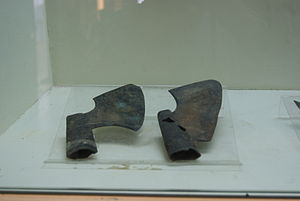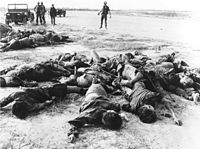- Military history of Vietnam
-
Army and warfare probably made their first appearance in Vietnamese history during the 3rd millennium BC. Throughout thousands of years, wars played a great role in shaping the identity and culture of people inhabited the land which is modern day Vietnam. The military history of the Socialist Republic of Vietnam began when Japan invaded French Indochina and soon defeated the French resistance. Since then, Vietnam has fought in many conflicts in Indochina.
Ancient time
Weapons are the most common Bronze age artifacts found so far.
Invasion of French Indochina
The Japanese invasion of French Indochina was a successful Japanese campaign against the French colonial power in Southeast Asia. The invasion was a part of a greater strategy which was meant to surround and isolate China. Following the fall of the French in Indochina, Viet Minh began its campaign against the Japanese occupiers, using guerrilla tactics. The conflict ended when Japan surrendered to the United States, following the bombing of Hiroshima and Nagasaki.
The First Indochina War
Following the allied victory in World War II, France was hoping to regain control over its former colony in Indochina, which was also claimed by the Viet Minh. France attempted to invade and reoccupy Vietnam, but after nine years of war, the French gave up and retreated from Indochina. This resultet in Indochina being divided into four countries: North Vietnam, South Vietnam, Laos and Kampuchea.
Laotian Civil War
The Laotian Civil War began in 1953 when war escalated between the government forces and Pathet Lao, which received support from North Vietnam and China. In addition to their desire to impose a communist government in Laos, Vietnam also wanted to control the strategically important areas in Laos. The conflict ended in 1975, when Pathet Lao seized power in Laos, ending the Kingdom of Laos.
North Vietnamese invasion of Laos
The North Vietnamese invasion of Laos begun in 1958 as a mixed result of boundary disputes and the Hanoi Regime's desire to control the Ho Chi Minh-path. The invasion was a success, and North Vietnam secured control over important parts of Laos.
Vietnam War
The Vietnam War started when North Vietnam and the Viet Cong attacked South Vietnam, seeking to reunite the country by force. This led to an American intervention, which lasted until 1973, when they withdrew their forces from Vietnam following a peace treaty. The war went on, and in 1975 North Vietnam emerged victorious.
Cambodian Civil War
The Cambodian Civil War was a mixed result of the Khmer Rouge's desire to establish a communist regime in Cambodia, and the American bombing of the country, eventually dragging Cambodia into the Vietnam War. Khmer Rouge was aided by North Vietnam and the Viet Cong, and won the war in 1975.
Invasion of Southwest Cay
During the Vietnam War, North Vietnam, South Vietnam and the Philippines had fought over control of Southwest Cay. When South Vietnam was annexed by North Vietnam and thereby ceased to exist, Vietnam preferred to take the island by force. The invasion was a success, and The Philippines lost control over the island.
Hmong Insurgency
When the Laotian Civil War ended in 1975, the government of Laos started to persecute the Hmong-tribes, who had been fighting alongside the United States in the Vietnam War. Vietnam has participated in the persecution, which has led to thousands of Hmong fleeing to the United States and Thailand. Although the Hmong no longer poses a military threath to the government of Laos, they are still categorized as "bandits" by the authorities.
Civil unrest in South Vietnam
After the Vietnam War was over, some groups in South Vietnam refused to accept the Hanoi regime as the legitimate government of Vietnam. The resistance lasted until the 1980s, when the rebellion ultimately failed.
Cambodian-Vietnamese War
When the Vietnam War ended, the Khmer Rouge, which then controlled Cambodia, claimed the Mekong Delta being a historical part of Cambodia. When Vietnam refused to cede the delta to Cambodia, the Khmer Rouge responded by conducting several border skirmishes, infiltrations and sabotage. By the late 1978, Vietnam invaded Cambodia, and after two weeks of fighting, Vietnamese forces captured Pnomh Penh. Vietnam occupied Cambodia until 1988.
Vietnamese border raids in Thailand
The Vietnamese border raids in Thailand was a Vietnamese attempt to stop the Khmer Rouge from using Thailand as a base when fighting against Vietnam and the Vietnamese-friendly regime in Pnomh Penh. This nearly lead to a war, as Vietnamese troops often penetrated into Thai territory, chasing Khmer Rouge-guerillas. This often resultet in clashes between Vietnamese and Thai forces. However, this never lead to a war.
Sino-Vietnamese war
The Sino-Vietnamese War was a Chinese attempt to force Vietnam out of Cambodia. China launched invasion of Vietnam, but faced much tougher resistance than expected. The Chinese invasion lost its progress relatively quickly. The Vietnamese conducted cross-border raids and succeeded in disrupting the Chinese fire support. When the initial offensive had been halted, a new wave of attack was sent in, and eight Chinese divisions were sent into Vietnam. The Chinese penetrated 15–20 km into Vietnamese territory at most, but the price of human life and equipment were very high. Vietnam did not mobilize its regular divisions, which was ment to protect Hanoi if necessary, and no troops were pulled out of Cambodia during the war. In Lang Son, the hardest battles took place. The city was heavily fortified by the Vietnamese Army, and it took 17 counter attacks before the Chinese were able to capture the city. The Vietnamese troops pulled out of the city itself, but established heavy positions in the surrounding mountains. Soon after, Deng Xiapong announced that China would pull out its forces. 25 Chinese Divisions of the Third Field Army had been taking part of the invasion. Not a single Vietnamese Regular Division had mobilized, and the Chinese invasion did not affect the Vietnamese presence in Cambodia. In less than a month, according to Western sources, the Chinese Army had suffered some 26,000 KIA and 37,000 WIA. Both sides claimed victory.
Second Sino-Vietnamese War
When China withdrew all their forces from Vietnam in 1979, they occupied some small areas along the border, and sometimes launched full-scale invasions of Vietnamese cities. The Vietnamese often responded with heavy force. The conflict ended in 1990, when China ended their campaign against Vietnam.
Thai-Laotian Border War
The Thai-Laotian Border War begun in 1987, when Thailand invaded parts of Laos which they claimed to be theirs. Laos responded with force, and the Thai forces were pushed back to the border. During this brief war, Vietnam reinforced its communist ally, and helped them in their war against Thailand. The war ended with a ceasefire in 1988, when Laos had successfully regained all lost ground, and pushed the Thai forces out of the country.
Categories:
Wikimedia Foundation. 2010.



